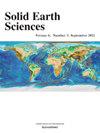长石在40-100℃草酸中的溶解行为:化学风化过程中Al富集的意义
IF 2
4区 地球科学
Q3 GEOSCIENCES, MULTIDISCIPLINARY
引用次数: 0
摘要
长石的溶解行为是理解地表物质循环、化学风化、矿物沉积和全球气候变化等地质过程的基础。在本研究中,我们选择自然界中最常见的有机酸之一草酸作为缓冲溶液,模拟长石在自然环境下的化学风化过程。通过34个流体-长石反应实验,探讨了温度、pH和比表面积对长石溶解机理的影响。基于PHREEQC次生矿物饱和指数模型,得到了长石的总溶解速率,其主要受pH和温度的影响,SSA起次要作用。Na、K、Ca和Si的溶解速率与温度和SSA呈正相关,而Al的溶解速率与SSA呈负相关,与温度呈弱相关。根据化学反应动力学,估计长石在草酸中的溶解反应级数约为0.47,表明长石的溶解速率主要受解吸过程控制。我们的新实验结果表明,铝的异常溶解行为可能是由于铝配合物在长石表面的形成,这对理解大陆地壳化学风化过程中铝的富集机制具有潜在的重要意义。本文章由计算机程序翻译,如有差异,请以英文原文为准。
Dissolution behavior of feldspar in oxalic acid at 40–100 °C: Implications for Al enrichment during chemical weathering
The dissolution behavior of feldspar is fundamental to understand geological processes such as surface mass cycling, chemical weathering, mineral deposition and global climate change. In this study, we select oxalic acid – one of the most popular organic acids in nature as a buffer solution to simulate the chemical weathering process of feldspar under natural environments. A total of 34 fluid–feldspar reaction experiments are performed to investigate the effects of temperature, pH, and specific surface area (SSA) on the dissolution mechanism of feldspar. Based on PHREEQC modelling of saturation index of secondary minerals, we obtain the overall dissolution rate of feldspar, which is predominantly influenced by pH and temperature, with SSA exerting a secondary effect. The dissolution rates of Na, K, Ca and Si show a positive correlation with temperature and SSA, whereas that of Al exhibits a negative correlation with SSA and a weak correlation with temperature. Based on chemical reaction kinetics, the reaction order of feldspar dissolution in oxalic acid is estimated to be approximately 0.47, suggesting that the dissolution rate of feldspar is primarily controlled by a desorption process. Our new experimental results reveal that the anomalous Al dissolution behavior, which are likely due to the formation of aluminum complexes on the feldspar surface, have potentially significant for understanding the Al enrichment mechanism during the chemical weathering of the continental crust.
求助全文
通过发布文献求助,成功后即可免费获取论文全文。
去求助
来源期刊

Solid Earth Sciences
GEOSCIENCES, MULTIDISCIPLINARY-
CiteScore
3.60
自引率
5.00%
发文量
20
审稿时长
103 days
 求助内容:
求助内容: 应助结果提醒方式:
应助结果提醒方式:


